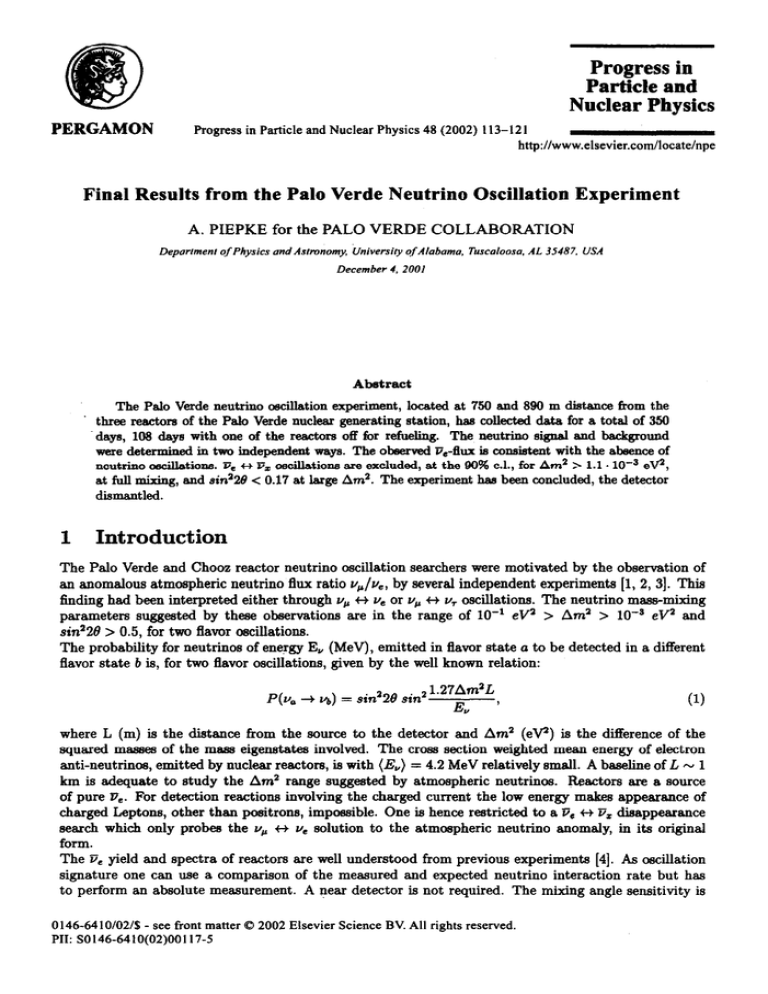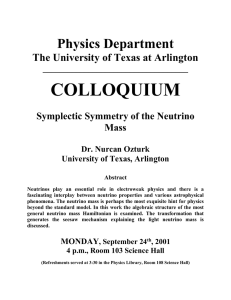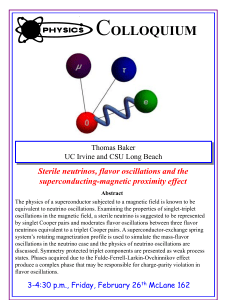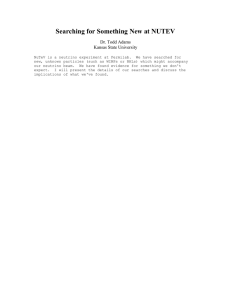
Progress in
Particle and
Nuclear Physics
PERGAMON
Progress in Particle and Nuclear Physics 48 (2002) 113-12 1
http:Nwww.elsevietcom/locate/npe
Final Results from the Palo Verde Neutrino Oscillation Experiment
A. PIEPKE for the PALO VERDE COLLABORATION
Lkporlmenr
qf Physics
andAstronomy, University
December
qfdlabama.
Tuscaloosa,
AL 35487.
USA
4. 2001
Abstract
The Palo Verde neutrino oscillation experiment, located at 750 and 890 m distance from the
three reactors of the Palo Verde nuclear generating station, has collected data for a total of 350
-days, 108 days with one of the reactors off for refueling. The neutrino signal and background
were determined in two independent ways. The observed &-flux is consistent with the absmce of
neutrino oscillations. i& f) 17, oscillations are excluded, at the 90% c.l., for Am* > 1.1. 10s3 ev,
at Ml mixing, and sin228 < 0.17 at large Am*. The experiment has been concluded, the detector
diimant1ed.
1
Introduction
The Palo Verde and Chooz reactor neutrino oscillation searchers were motivated by the observation of
an anomalous atmospheric neutrino flux ratio v,,/Y=, by several independent experiments [l, 2,3]. This
finding had been interpreted either through vc( ++ v, or u,, f) v, oscillations. The neutrino mass-mixing
parameters suggested by these observations are in the range of 10-l eV* > Am* > low3 eV* and
sin228 > 0.5, for two flavor oscillations.
The probability for neutrinos of enera E, (MeV), emitted in flavor state a to be detected in a different
flavor state b is, for two flavor oscillations, given by the well known relation:
P(ua + ub) = sin228 sin*
1.27Am2L
E,
’
where L (m) is the distance from the source to the detector and Am* (eV’) is the difference of the
squared masses of the mass eigenstates involved. The cross section weighted mean energy of electron
anti-neutrinos, emitted by nuclear reactors, is with (Ew) = 4.2 MeV relatively small. A baseline of L - 1
km is adequate to study the Am* range suggested by atmospheric neutrinos. Reactors are a source
of pure 17,. For detection reactions involving the charged current the low energy makes appearance of
charged Leptons, other than positrons, impossible. One is hence restricted to a Do t) pz disappearance
search which only probes the v,, f+ v, solution to the atmospheric neutrino anomaly, in its original
form.
The Do yield and spectra of reactors are well understood from previous experiments [4]. As oscillation
signature one can use a comparison of the measured and expected neutrino interaction rate but has
to perform an absolute measurement. A near detector is not required. The mixing angle sensitivity is
0146-6410/02/S - see front matter 0 2002 Elsevier Science BV. All rights reserved.
PII: SO146-641 O(O2)OO
117-S
114
A. Piepke / Prog. Part. Nucl. Phys. 48 (2002) 113-121
limited by the statistical accuracy of the measured rate.
Two independent experiments have been performed to search for neutrino oscillations at a distance of
about 1 km from nuclear reactors. With L/(E,) N 200 m/MeV these were the first dedicated “long
baseline” experiments. Both the Palo Verde [5] and the Chooz [6] experiment were able to exclude
v,, ++ v, oscillations as the dominant mechanism for the atmospheric neutrino anomaly. This confirms
newer Super-Kamiokande results clearly favoring uI1H v, oscillations [7].
2
Experimental Procedure
The Palo Verde nuclear generating station consists of three identical pressurized water reactors with
a thermal power of 11.63 GW each. The neutrino detector was situated 750 m from one of them and
890 m from the two others. To suppress the cosmic radiation the detector was located in a shallow
underground lab with an overburden of about 32 mw.e.. While this depth sufficed to eliminate the
hadronic component of the cosmic radiation the muon flux was with 22 rnm2sm1still relatively high,
resulting in a substantial production of tertiary neutrons in the laboratory walls.
As neutrino detection reaction we utilized inverse beta decay:
57,+p+e++n,
(2)
offering both a “high” cross section (at our energies about 6. 1O-43 cm2/fission) and convenient active
target material in form of hydrogen rich liquid scintillator. The reaction threshold is with 1.8 MeV
relatively low. The utilization of the capture of the reaction neutron allows to make use of a delayed
coincidence counting scheme, greatly reducing the background. The anti-neutrino target consisted of
11.3 tons of 0.1% Gd loaded liquid scintillator, which had been developed for this’ experiment [8].
The high thermal neutron cross section of Gd resulted in a tight positron-neutron correlation time of
Tag = 28 ~8. Furthermore Gd releases a 8 MeV gamma cascade after neutron capture, giving a robust
capture tag.
Figure (1) depict8 the detector. The target was contained in 66 9 m long acrylic tanks, viewed by
two low background 5” PMTs at either end. These were separated though a passive oil buffer from
the active detector to reduce background. The detector segmentation allowed a two dimensional vertex
reconstruction, with the third dimension determined by the different arrival times of the scintillation
light at the PMTs. On the trigger level a neutrino candidate event required three tanks to fire in a
fast coincidence. One “high” hit (more than ~0.6 MeV energy deposit in the center of any cell) was
associated with the kinetic energy of the reaction positron. Two “low” hits (more than ~0.05 MeV
energy deposit in the center of the cell) had to occur in adjacent cells, flagging the annihilation radiation.
The difference8 in event topology for annihilation-like and background events allowed an active on-line
background rejection. Two triple events within 450 ps of each other would initiate event readout for
off-line analysis. A smart, field programmable event trigger was used [9].
The central detector was surrounded by a 1 m thick water buffer, reducing both the ambient gamma ray
and neutron flux. The set up was housed in a tight 47r veto, build from large liquid scintillation tanks,
most of which had been obtained from the MACRO experiment. The veto inefficiency was measured
to be 2.5 f 0.2% and 0.07 f 0.02% for stopping and through going muons, respectively.
Stable detector operation wag verified through weekly calibration8 with light flashers. The energy scale
was defined using =Na and AmBe sources. Cross checks were provided through runs with aZn 13’Cs
and z2aTh sources. The positron and neutron detection efficiencies were determined by means of ‘Monte
Carlo simulation. Thii is a central point for an experiment based on the absolute determination of the
neutrino flux. Great care was taken to tune these calculations through repeated measurements with
various calibration sources. Light attenuation effects were calibrated several time over the life of the
experiment by performing 3-dimensional source scans over the whole detector volume using the 228Th
A. Piepke / Prog. Part. Nucl. Phys. 48 (2002) 113-121
Muon Veto
115
CentralDetector
Figure 1: The Palo Verde detector. One of the 66 target cells, with its optical calibration
devices, is shown lengthwise at the bottom.
source. Our scintillator exhibited good stability towards aging. All experimental details have been
published [5] and will therefore not ,be repeated here. Data was taken in “runs”, typically lasting a day.
The expected anti-neutrino candidate rate &re is given by:
(3)
where a(Ev) is the differential cross section taken form [lo], @I(&) the neutrino spectrum emitted by
reactor i at distance Li, v(Ev) the energy dependent detection efficiency and ns is the number of free
protons in the target. The fuel burn-up enters through the evolution of @i(Ey) into the calculation.
Our model was based on a daily log of the thermal reactor power and the fission rates of the nuclides
=QPll, s41pu, zs5U and 2ssU. The two flavor neutrino oscillation probability Po8c.iwas taken as defined
in equation (1). Figure (2) shows our pe reaction yield model covering the duration of the experiment.
3
Results
The on-line rate of correlated events was about 1 s-r with a raw triple event rate of 50 s-l.
following off-line cuts were applied to the data to arrive at the final Fe-candidate data set:
The
1. At least one hit was reconstructed with E >l MeV in both prompt and delayed triples and at
least two additional hits showed E >30 keV. No single hit was allowed to be greater than 8 MeV.
2.
The prompt triple was required to resemble a positron, i.e. annihilation 7’s each less than 600
keV, and together less than 1.2 MeV. (This cut was the only one which treated the two triples
asymmetrically).
116
A. Piepke / Prog. Part. Nucl. Phys. 48 (2002) 113-121
175
150
125
100
75
50
25
Figure 2: Calculated pe interaction rate in the target for the caee of no oscillations, The
periods of reduced rate correspond to the refueling outages. The rate variations at full power
are due the fuel burn up.
At least one of the two ttiples in the event had more than 3.5 MeV of reconstructed
rejection of 7 backgrounds.
energy for
The prompt and delayed portions of the event were correlated in space and time (within 3 columns,
2 rows, one meter longitudinally, and 200 ~8).
The event started at least 150 ,os (~5 neutron capture times) after the previous veto tagged muon
activity.
Application of these selection criteria reduced the rate to a more manageable 50 events per day. The
neutrino analysis has to unfold the neutrino signal from the background. Correcting this rate by
the detection efficiency of about 11% (see table (1)) yields a rate of 440 d-l, which clearly exceeds
the maximum expected neutrino signal of 225 d-l (see figure (2)) without oscillations. A reliable
background determination is hence crucial to derive a physics result.
The detector background was composed of two components:
1. Random coincidences mainly caused by radioactivity.
It can be measured together with the
neutrino signal through events with very long delay time between primary and secondary subsignal. The hardware cut-off for the inter-event time of 450 ps corresponded to about 16 neutron
capture times, it was hence long enough to allow determination of the random background to be:
4.1 f 0.2 d-l.
2. The principal source of background were fast neutrons which created the primary event through
proton recoil and eventually captured. These were true correlated events. Multiple neutrons also
significantly contributed to the background. This was demonstrated by the observation that the
capture time for events correlated with activity in the veto detector showed a shorter correlation
time than expected. The Palo Verde data was used to determine the production rate of tertiary
muon induced neutrons at shallow overburden [ll].
A. Piepke / Prog. Part. Nucl. Phys. 48 (2002) 113-121
117
Table 1: Data taking periods, efficiencies (including lifetime, labeled eff.), measured event rates, and
results of the swap analysis (see text), including the various background estimates. Uncertainties are
statistical only.
Period
1998
1999-I
1999-11
2000
Reactor
890 m off
890 m o
890 m off
on
750 m off
3:*
time (d)
27.5
29.6
8;2
21.8
60.4
6:2
29.4
11.6
11.6
11.6
11.5
10.8
8.0
8.0
10.9
eff. (%)
RI
R2
(1 -
4Bpn
Backgr.
39.6 f 1.1
25.1 f 0.9
34.8 f 1.1
21.8 f 0.9
54.9 f 0.9
33.4 f 0.7
0.88
0.89
1.11
292 f 11
202 f 19
216
255 f 10
182 f 18
154
265 f 6
212 * 10
218
measured rates (d-l)
45.1 f 1.4 54.2 f 0.9
32.0 f 1.2 32.5 f 0.7
49.4 f
32.6 i
256 f 6
214 f 11
220
52.9 f 0.8
30.2 f 0.6
43.1 f
30.4 f
1.07
1.07
265 f 9
161 zt 15
155
249 f 5
237 f 10
218
272 f !
129 f 1
154
The data is summarized in table (1) which lists the observed event rates Ri, grouped into 8 periods
(delined by the reactor power schedule) to reduce the statistical fluctuations. The event rates at reduced
power are clearly lower than those recorded at full power.
3.1
Reactor Power Analysis
This is the ‘Lclassical” way to extract the modulated neutrino signal from a constant background. The
critical point is to show that the background was in fact constant in time. This was verified by reversing
some of the selection cuts in order to obtain high statistics background data sets. These allowed to
study the temporal behavior of various background components and confirmed a stable background.
Figure (3) shows the measured dead time and neutrino efficiency corrected event rates &,
plotted
versus the neutrino signal rate expected for no oscillations. If the data were consistent with no oscillations and the background were constant, then the points should lie along a straight line with unity
slope. The intercept can be interpreted as the background scaled by the Pe detection efficiency. The fit
of a straight line to the data yields a slope of 1.011 f 0.104dst at a reduced x2 of 0.89. The statistical
signiiicance of the observed V~ signal is 9.7u. The data is in fact consistent with the hypothesis of no
oscillations. The background derived from this fit is 257.5 f 20.Tt” d-l.
To construct the confidence area in the Am2 - sin228 plane we performed a x2 analysis. Let K,+ be
the event rate, and ai its statistical error, measured in run i. Let B be the background rate and LYan
overall normalization, bound by the systematic uncertainty q+, estimated to be 0.061. We define the
test statistic x2 as:
(o&&Am2,
x2((u, B, Am2, sin228) = c
1
sin226’) + B - ab,i)2
u,’
+ (CX- 1)2
2.
Osyst
(4)
The following analysis was based on the data binned as shown in table (1). A run-by-run analysis gave
comparable results.
x2 was minimized with regards to Q, B, Am2 and sin220 on a fine grid in the Am2 - sin220 plane. The
best fit obtained was identical to the no oscillation fit (Am’ = sin220 = 0) consistent with the absence
of neutrino oscillations.
The 90% c.1. acceptance region is defined according to the procedure suggested by Feldman and
Cousins [12] by determining the change in x2 during the grid search:
Ax2 = x2(Am2, sin2 28) - xteat > A<tit(Am2,
1
1
1.11
1.11
1.11
efficiency corrected rates (d-l)
266 f 10
124 f 17
129
1.3
1.0
sin2 20)
(5)
118
A. Piepke / Prog. Part. Nucl. Phys. 48 (2002) 113-121
-
524-I
9
2
..
500
R_
= (1.011 f 0.104).Rd
1
x’=
+ (257.5 f 20.7) day-’
0.89
480 -
460 -
890moff
44.0
420
750 m off
380
jf
360
loo
120
140
160
180
200
220
Figure 3: The event rates Reap for different data taking periods, corrected for dead time and
neutrino detection efficiency, plotted versus the expected neutrino interaction rate &c for
no oscillations. Errors are statistical only. Points corresponding to data taking periods with
the same reactor power conditions should lie on top of each other. Also shown is the result,
discussed in the text, of a linear fit to the data.
where x2(Am2, sin’ 28) is the minimized fit quality at the current point in the Am2 - sin220 plane.
Clearly a large Ax2 indicates a big deviation from the best fit and therefore signals disagreement with
the data. Quantitatively Ax%,, the x2 acceptance cutoff at the given c.l., was obtained through Monte
Carlo simulation.
This procedure is rather time consuming and cumbersome. An alternate construction of the confidence
area used the so called raster scan. In this analysis a global best fit is not constructed but sin228 is
minimized for fixed Am2 instead. This is repeated for each Am2 value of interest. The confidence region
is then the union of all one dimensional confidence intervals calculated. The unified analysis [12] is now
much simplified as we are only dealing with a one dimensional problem. The exclusion plot labeled
“reactor power” in figure (4) was based on a raster scan. The full Monte Carlo analysis delivered a
nearly identical result.
3.2
The Swap Analysis
In the “swap analysis” most of the background is directly subtracted rather then using the information on the reactor power. It has therefore a substantially greater statistical power and a different
systematics, at the expense of a somewhat stronger reliance on the Monte Carlo simulation. A detailed
description of the method has been published [13].
Let RI be the observed event rate after applying the neutrino selection cuts, let R2 be the rate obtained when applying the neutron cuts to the positron like sub-event and the positron selection cuts
to the neutron like sub-event (“swapped” selection). In the difference RI - R2 the two-neutron and
119
A. Piepke /Prog. Part. Nucl. Phys. 48 (2002) 113-I21
101
0
0.1
0.7.
0.3 0.4 0.5 0.6 0.7 0.8 0.9 1
d2e
Figure 4: Am2 sin220 exclusion plot. The 90% cl. limits obtained by the “reactor power”
(dashed line) and the “swap” (solid line) analysis are shown in comparison to the Chooz [6]
exclusion and the allowed parameter range of the original Kamiokande experiment [l].
random backgrounds cancel, while only 20% of the anti-neutrino signal cancels. The contribution of
the proton-neutron scattering background is given by (1 - ~$3~~. It is dominated by neutrons created
in muon spallation in the laboratory walls and muon capture inside the detector. While neutron production through muon capture is well understood and can be reliably calculated through Monte Carlo
simulation, the spallation is rather poorly known. The spectral shape of the spallation neutrons was
obtained by Monte Carlo using several parametric models selected to span the range of uncertainty in
our knowledge of the energy dependence of neutron production. The normalization was then obtained
by assuming that all events with a prompt energy of greater than 10 MeV are exclusively due to spallation. The dispersion between the different neutron flux models was taken into account in the systematic
error. The quantity (1 - ei)B,,, was then determined period by period. Its magnitude is small compared
to RI - R2 so that its contribution to the background largely cancels in the difference. Therefore even
a systematic uncertainty of 100% in (1 - ~i)&,~ results in only a few percent contribution to the error
of the neutrino signal. Table (1) lists the quantities relevant in the swap analysis period by period.
Similarly to the reactor power analysis, we have carried out a x2 analysis to test our data for oscillations
throughout the Am2 - sin’ 20 plane. The x2 definition was:
8
~'(a,
Am2, sin220) = c
i=l
(&,i - R2,i - (1 -+$m
- +::c
ui"
- $&))2
+
(a-
I)~
(6)
2
*wt
where uBPt for the “swap” method is estimated to be 0.053 as discussed below. The free parameters in
this definition of the x2 are Am2, sin2 20, and cr. The Monte Carlo method gives xfJd.0. j. = 10.3/7
for sin2 28 consistent with zero and a slightly un-physical a = 1.008.
The region of parameter space excluded at the 90% c.1. by this analysis, based on the raster scan
120
A. Piepke /Prog.
Part. Nucl. Phys. 48 (2002) 113-121
method, is indicated by the solid curve in Fig. (4). In the limit of large Am*, the range sin* 20 > 0.168
is excluded; whereas in the limit of large mixing, the range Am* > 1.1 x 10e3 eV* is excluded. We note
that, in the limit of large Am*, the Monte Carlo method excludes the range sin* 26 > 0.165, and gives
an essentially identical exclusion curve.
The systematic uncertainty has contributions from the detection efficiency, the flux calculations. The
Table 2: Contributions to the systematic error of the “reactor power” and “swap” analyses.
Error source
“reactor power” (%) “swap” (%)
e+ trigger efficiency
2.0
2.0
n trigger efficiency
2.1
2.1
Doflux prediction
2.1
2.1
Deselection cuts
4.5
2.1
Background variation
2.1
N/A
(1 - ci)B,, estimate
3.3
N/A
Total
6.1
5.3
“reactor power” method suffers a systematic error from possible background variations in time, while the
“swap” analysis has an error contribution from the estimate of (1 - ci)&,. The individual contributions
are shown in Table 2 and were added in quadrature to obtain the total systematic error for each analysis
method.
The analysis of the energy distribution of the neutrino candidate events provides an addition oscillation
l
-
data
MC no 08cillation
2
0
1
2
3
4
5
6
7
Figure 5: Prompt energy spectrum after on-oflsubtraction.
The histograms show the expectations for no oscillation (solid line) and Kamiokande best fit (dashed line).
check. For each of the pairs of on-off periods one may subtract the spectrum taken at partial power
from that taken at full power. After a small correction for fuel burn-up, the resulting spectrum is due
A. Piepke /Prog. Part. Nucl. Phys. 48 (2002) 113-121
121
the reactor which has been refueled during the off period. Figure (5) shows the weighted average
of all four on-off periods, without efficiency and dead time correction. Also shown are the spectra we
would have expected based on the Kamiokande [l] best fit for uI1 f) v, oscillations (x’/d.o.f. = 3.69
for eight degrees of freedom) and no oscillations (x2/d.o.f. = 1.39) In agreement with the two previous
analysis also the energy spectrum supports the no oscillation hypotheses.
to
4
Conclusion
The Palo Verde data is consistent with the absence of ve f) I& oscillations. This conclusion has
been derived through two independent analysis techniques. Through the “swap” analysis, yielding
the more restrictive bound, we determined the ratio of observed interaction rate to expected to be:
N.,b/&c
= 1.01 f 0.024 stat f 0.0538pt. These 6naI results are dominated by systematic8 errors.
Our data exclude two family u,,-v, mixing ss being responsible for the anomaly reported by Kamiokande [l].
This result confirms those of the Chooz [6] and and Super-Kamiokande [7] experiments.
The PaIo Verde Collaboration: F. Boehm, J. Busenitz, B. Cook, G. Gratta, H. Hen&son, J. Kornis,
D. Lawrence, K.B. Lee, K. McKinney, L. Miller, V. Novikov, A. Piepke, B. Ritchie, D. T&y, P. Vogel,
Y-F. Wang, J. Wolf
References
[l] Y. Fukuda et al., Phys. Lett. B 335 (1994) 237
[2] R. Becker-Szendy et al., Phys. Rev. Lett. 69 (1992) 1010
[3] E. Peterson et al., Nucl. Phys. B Pnx. SuppL 77 (1999) 111
[4] G. Zacek et al., Phys. Rev. D 34 (1986) 2621
Y. Deciais et al., Nucl. Phys. B 434 (1995) 503
[5] F. Boehm et al., Phys. Rev. D 62 (2009) 072002
F. Boehm et al., Phys. Rev. D 64 (2001) 112001
[S] M. Apollonio et al., Phys. Lett. B 466 (1999) 415
[7] Y. Fukuda et al., Phys. Rev. Lett. 81 (1998) 1562
S. Fukuda et al., Phys. Rev. Lett. 85 (2000) 3999
[8] A. Piepke, S.W. Moser and V.M. Novikov, Nucl. Inst. Meth. A 432 (1999) 392
[9] G. Gratta et al., Nucl. Inst. Meth. A 400 (1997) 456
[lo] P. Vogel and J. Beacom, Phys. Rev. D 60 (1999) 053003
[ll] F. Boehm et al., Phys. Rev. D 62 (2000) 092005
[12] G. J. Feldman and R. D. Cousins, Phys. Rev. D 57 (1998) 3873
[13] Y.F. Wang et al., Phys. Rev. D 62 (2000) 013012





